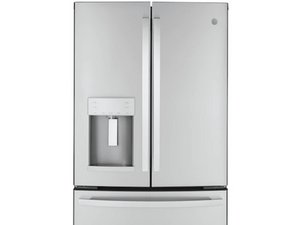Puzzle for a refrigeration genius.
I have a situation that has me completely baffled.
It’s a 23-yr-old GE side-by-side.
Here’s what’s been replaced in the past few years:
• defrost heater element
• thermistors in both freezer and fridge
• thermostat in freezer
• evaporator fan motor
• main circuit board
The last repair was the last two items in that list.
After that, the fridge worked perfectly. Actually, TOO perfectly --- I had to turn down the cooling setting for the freezer from 9 to 4 because it was going down to almost -20°F!
Everything was fine for a few weeks after that. Fridge was between 34° - 38°. Freezer hovered around 0° or just below.
Then suddenly one day the ice cubes were melting and ice cream had gone soft. I cranked the freezer back up to the 9 and it was okay for a few days but then couldn’t manage to get below 32°. Fridge was at a steady 38° - 40° and that’s all.
I presumed the new board had failed so I put in a warranty claim and got a replacement.
Unfortunately, the replacement board did not change anything.
After 24 hours, both the fridge and freezer remained at the same temps they were at with the original board. Freezer at 32°; fridge at 38°.
Needless to say, I was very disappointed. But I was determined to investigate WHY it still couldn’t achieve the correct temp.
I stuck my hand in the freezer and noticed that the air flow from the evaporator fan vents didn’t seem to be as strong as it should, or as strong as I remembered.
I thought, okay, maybe there’s an issue with the defrost heater element (even though it’s only 4 yrs. old) and there might be an ice build-up on the freezer coils and it’s blocking the air flow.
So the next day I pulled off the panel that covers the freezer coils.
Nothing there. Totally ice-free, except for a few remaining icicles still melting off two rows near the bottom.
But I decided to leave the panel off for a couple hours and see what happened. The coils frosted up nicely and the freezer went down to 4°.
So I reassembled everything (but didn’t screw it in) and waited to see what happened overnight.
Next morning, freezer and fridge were AGAIN at 32° and at 38°.
I pulled the panel off again and waited longer this time. After about 3 hours, the freezer got down to -2°F!
So I think that definitely rules out a compressor or circuit board issue.
Since the only logical conclusion appeared to be an air flow problem, I did some more examinations of the fridge ...
1. Checked the vent and damper from the freezer to the fridge. No blockage and damper is opening and closing properly.
2. Checked the defrost drainage tube to see if maybe there was an ice blockage there. Nope; totally clear.
3. Checked the condenser coils next to the compressor. Still clean except for a slight, fine layer of dust.
The only other thing I can think of related to air flow – and I REALLY hope this isn’t it – is that the new evaporator fan is not running at the proper RPM.
But when I looked at it, it looked fine. The blades were moving fast and smoothly. I have no way of measuring the RPM, of course, but it looked like the right speed to my layman’s eye.
But WHY is it suddenly not able to get enough air through that space when the panel is in place but doing fine when the panel is off?
I am totally stumped.
Can anyone help me solve this mystery?
crwdns2934109:0crwdne2934109:0


 1
1 
 26
26  32
32 
Hi @jamesthean91304,
What is the model number of the refrigerator?
crwdns2934271:0crwdnd2934271:0 jayeff crwdne2934271:0
@jayeff
It's GSS201BPAWW. BTW, that's a Canadian model number. The U.S. one is slightly different, I think.
crwdns2934271:0crwdnd2934271:0 James The Anonymous crwdne2934271:0
@jamesthean91304
Did you replace both of the temperature sensors (thermistors) along with the defrost thermostat in the freezer compartment? (see part #241 and #242 - defrost thermostat is part #240)
crwdns2934271:0crwdnd2934271:0 jayeff crwdne2934271:0
@jayeff
Yes, all are practically new. Freezer thermostat replaced about two years ago. Still looks good; no bulging or cracks. New thermistor in the fridge last August and a new thermistor was included/attached to the new evaporator fan.
crwdns2934271:0crwdnd2934271:0 James The Anonymous crwdne2934271:0